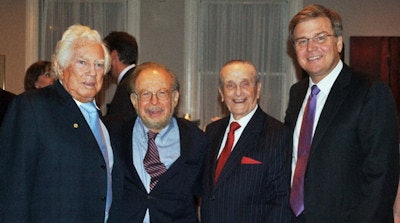
DrBicuspid.com is pleased to present the next installment of Leaders in Dentistry, a series of interviews with researchers, practitioners, and opinion leaders who are influencing the practice of dentistry.
We spoke with Ronald Bulard, DDS, CEO and president of Park Dental Research, which was founded in 1967 and is considered one of the oldest dental implant companies in the world. Dr. Bulard has been a major influence in the development and proliferation of implant dentistry. An inventor who currently holds seven patents related to dentistry, Dr. Bulard merged the "o-ball" concept with Victor Sendax's mini dental implant (MDI) design. He is also founded Imtec in 1990. Imtec was acquired by 3M ESPE in 2008; in 2011, Dr. Bulard acquired all shares of Park Dental.
Dr. Bulard shared his thoughts on the current state of implantology and how Luciano Pavarotti changed his entire perception of MDIs' role in dentistry.
Dr. Bicuspid.com: How did your career become so focused on dental implants?
 From left to right: Drs. Leonard Linkow, Victor Sendax, Jack Wimmer, and Ronald Bulard.
From left to right: Drs. Leonard Linkow, Victor Sendax, Jack Wimmer, and Ronald Bulard.
Dr. Bulard: It started back in junior high, believe it or not. My uncle was a dentist in Altus, OK. I remember going over for Thanksgiving and he had done a surgery the day before. He had done a vitreous carbon implant and went to check on the patient. Then in school, I wrote this paper about how I wanted to place dental implants -- my mother still has it. So I've known what I wanted to do since early on in life; some folks develop a passion, and I guess mine is dental implants.
How did you begin working with them professionally?
While I was in dental school, you were a bit of a charlatan if you were placing implants. They weren't really accepted. Then in 1984, Per-Ingvar Brånemark, MD, PhD – considered the father of osseointegration-- held a seminar in Canada and I was invited. There I found that another doctor was even making implants in his garage with a computer numerical control milling machine, and I realized that anyone who had access to one of these machines could make them.
Upon graduating from the University of Oklahoma dental school in 1985, I drew up some designs. Implants at the time were either the Brånemark-type that had a hex on top or they were Calcitek type that you would press into the bone. I wanted to combine the hex on top of a press fit. Then I found an aircraft parts company in Oklahoma and started making and selling them to my colleagues.
Then we got into the two-piece implant design that Dr. Brånemark made popular. Everyone became what I called "Brånewashed" because we all followed this protocol that he put in place for about 10 years.
In the late 1980s, when the breast implant problem occurred, the U.S. Food and Drug Administration (FDA) increased its oversight of dental implants.
In 1990, I founded Imtec. We were manufacturing two-piece implants like everyone and being innovative, although I was behind some of the other companies.
At what point did your focus shift to MDIs?
My office in Oklahoma was too difficult to get to for these dentists arriving from all over to learn about placing implants. So I added a location at 30 Central Park South in Manhattan. Location is important in the city when trying to establish credibility among thousands of dentists.
I ran an ad noting that I was a Diplomat of the American Board of Oral Implantology and offered my services to dental patients. A local dentist complained to the New York Dental Board that I was advertising a specialty not recognized by the ADA -- i.e., advertising that I was a specialist in implant dentistry. I was board-certified by the American Board of Oral Implantology at the time, which New York allows you to advertise. So I dialed the then president, Victor Sendax. I told him I needed to talk about a problem and asked if we could meet -- and it turns out he was a few floors above me.
When I get to the door of his office, it read, "The Mini Dental Implant Center." I didn't have a clue what that was. But I'll never forget that when I went into his office, he had Luciano Pavarotti in there and was working on him. It was an interesting meeting because he was showing me these implants, and at the time I was Brånewashed, and these small-diameter implants, as far as I was concerned, were temporary. You put 'em in, take 'em out, and that was the ball game.
But what I learned from Victor is that if you're a high-profile individual and you've got a busy schedule, the idea of having a two-stage surgery where you have the implants put in, deal with discomfort, and wear a partial denture can be embarrassing if you're, say, a public speaker. Now imagine being an opera singer! You're trying to sing, but we're telling you that we're going to stick a denture in your mouth and you're going to perform with it. It could kill your career.
Victor had worked with Isaiah Lew, who developed small-diameter implants that he placed after drilling a full-depth osteotomy. Early on, they were made of the wrong material and screwed in wrong, but what Victor discovered was that if he put the implant in without drilling a hole first, that about 95% of them worked. But if he drilled and then screwed the implant in, only about 40% to 50% of them would work.
Victor patented the idea of insertion protocol. He showed me case after case, but I was still skeptical because it didn't seem supported properly. He said, "Just go try it." So I did and, sure enough, it worked.
I realized then that the mini-implant had a lot of potential. The problem I had was to market this product and convince dentists to do this because not everyone could have a chance to see what I saw. I convinced Victor that I needed to modify the implant and put an o-ball on top of the implant. I made it so it was designed primarily to stabilize someone's denture.
So that led to the shift in focus at Imtec.
Right. In 1997, I started selling the first Imtec mini-dental implants. They had an o-ball on top of them, and we designed a keeper cap that made it so it was tissue-supported but implant-stabilized. That was the biggest problem that I saw in elderly denture patients: They'd get their denture, and it would want to move around in their mouth. Being able to stabilize that is a huge business. Think of all the denture adhesives sold each year and the irritation fibromas under dentures that are ill-fitting.
Being able to stabilize the patient's denture was our first marketing approach. Few were buying mini dental implants back then, and if they were, it was to stabilize an implant prosthesis while their implants healed; it was usually done for three to six months, and the implants were taken out. So we began a training program about how to place mini-implants.
When you're in Ardmore, OK and you're trying to build your practice, you'll get a few patients that can afford a full upper or full lower implant case that, at that time, would average between $35,000 to 55,000 per arch. But that group of patients will soon be gone. There was this whole group of patients in my area that wanted implants but couldn't afford them. And what I found in New York was a lot of the opposite. People wanted implants and they had the money, but they just didn't have the time to have the procedure done. A CEO can't give up three to six months to go get implants done. So why would a guy like Pavarotti, who has all the money in the world, want MDIs? What I learned was that minis are not only for those who can't afford conventional implants but also for a very wealthy person who can't give up the time.
So being able to stabilize something as fast as the MDIs could stabilize their upper or lower teeth was amazing. It changed the way I think about implant dentistry. And we were offering a procedure with no incision, with minimal anesthetic, and with the patient being able to walk out of the office and chew their favorite food an hour after the implants are placed in a minimally invasive fashion.
How has the market changed since then?
The implant market today is about value -- it's a complicated business. I feel like the mini-implant market has suffered from neglect and complacency by some big players in the market -- they have not innovated. There have been a lot of system emulators and people manufacturing small-diameter implants that simply don't understand the product today.
I started Imtec for a $50,000 investment. When I sold it in 2008 to 3M, we had nearly $50 million in sales. The majority of that was MDIs, the fastest-growing segment of dentistry at the time. When I left the market (after the sale of Imtec), everybody wanted to learn how to place them, and there wasn't a lot of competition in that field.
Innovation -- you have to have it. MDIs are a mature market. To come out with ceramics or a new type of implant or tooth bud that changes implant dentistry, that's where innovation comes in. The big companies are owned by larger companies where bureaucracy can stifle innovation. The smaller companies will supply that.
What are some examples of innovation that will keep moving implants forward?
We took the MDI and looked at what's wrong without changing core components: We looked at the o-ball, and asked, "How do you make it last longer with daily wear and tear?" Then we hardened the metal.
Then there's the labyrinth groove process. Gingival cells have contact inhibition to alert them when to stop proliferating. This is significant in the implant being secure because we put a labyrinth groove collar around it. This keeps tissue from growing down the side of the implant faster than bone can grow up and integrate around the root of the implant.
The next important feature addresses how to make an implant stay screwed into the bone. We looked at the clock: As the gear turns, a pin falls and won't let it go backward. We have a cog lock undercut on implant so if you turn it counterclockwise, it grips into the bone.
Here's a good example of a poor implant innovation. A screw will auto advance into a hole that you've drilled into wood, for example. But if I drill into bone first, the cells have to die back and then grow in. If you only screw it in, they are compressed back. The tip becomes a very important thing.
Designs now have a cutting flute. They don't understand that cutting on the way in basically makes it a drill bit. And so it has a high failure rate -- about 50%. The tip is very important. If it's too sharp, it goes through different densities without the practitioner knowing it. The tip has to be blunt enough to feel differences in bone densities.



















